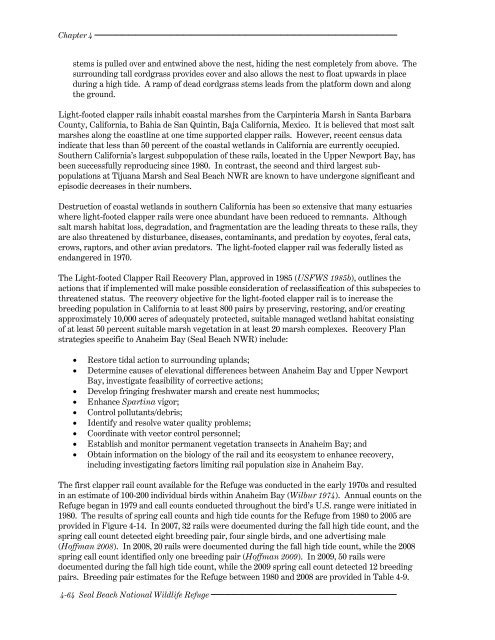Chapters 1 - U.S. Fish and Wildlife Service
Chapters 1 - U.S. Fish and Wildlife Service
Chapters 1 - U.S. Fish and Wildlife Service
You also want an ePaper? Increase the reach of your titles
YUMPU automatically turns print PDFs into web optimized ePapers that Google loves.
Chapter 4 <br />
stems is pulled over <strong>and</strong> entwined above the nest, hiding the nest completely from above. The<br />
surrounding tall cordgrass provides cover <strong>and</strong> also allows the nest to float upwards in place<br />
during a high tide. A ramp of dead cordgrass stems leads from the platform down <strong>and</strong> along<br />
the ground.<br />
Light-footed clapper rails inhabit coastal marshes from the Carpinteria Marsh in Santa Barbara<br />
County, California, to Bahia de San Quintin, Baja California, Mexico. It is believed that most salt<br />
marshes along the coastline at one time supported clapper rails. However, recent census data<br />
indicate that less than 50 percent of the coastal wetl<strong>and</strong>s in California are currently occupied.<br />
Southern California’s largest subpopulation of these rails, located in the Upper Newport Bay, has<br />
been successfully reproducing since 1980. In contrast, the second <strong>and</strong> third largest subpopulations<br />
at Tijuana Marsh <strong>and</strong> Seal Beach NWR are known to have undergone significant <strong>and</strong><br />
episodic decreases in their numbers.<br />
Destruction of coastal wetl<strong>and</strong>s in southern California has been so extensive that many estuaries<br />
where light-footed clapper rails were once abundant have been reduced to remnants. Although<br />
salt marsh habitat loss, degradation, <strong>and</strong> fragmentation are the leading threats to these rails, they<br />
are also threatened by disturbance, diseases, contaminants, <strong>and</strong> predation by coyotes, feral cats,<br />
crows, raptors, <strong>and</strong> other avian predators. The light-footed clapper rail was federally listed as<br />
endangered in 1970.<br />
The Light-footed Clapper Rail Recovery Plan, approved in 1985 (USFWS 1985b), outlines the<br />
actions that if implemented will make possible consideration of reclassification of this subspecies to<br />
threatened status. The recovery objective for the light-footed clapper rail is to increase the<br />
breeding population in California to at least 800 pairs by preserving, restoring, <strong>and</strong>/or creating<br />
approximately 10,000 acres of adequately protected, suitable managed wetl<strong>and</strong> habitat consisting<br />
of at least 50 percent suitable marsh vegetation in at least 20 marsh complexes. Recovery Plan<br />
strategies specific to Anaheim Bay (Seal Beach NWR) include:<br />
Restore tidal action to surrounding upl<strong>and</strong>s;<br />
Determine causes of elevational differences between Anaheim Bay <strong>and</strong> Upper Newport<br />
Bay, investigate feasibility of corrective actions;<br />
Develop fringing freshwater marsh <strong>and</strong> create nest hummocks;<br />
Enhance Spartina vigor;<br />
Control pollutants/debris;<br />
Identify <strong>and</strong> resolve water quality problems;<br />
Coordinate with vector control personnel;<br />
Establish <strong>and</strong> monitor permanent vegetation transects in Anaheim Bay; <strong>and</strong><br />
Obtain information on the biology of the rail <strong>and</strong> its ecosystem to enhance recovery,<br />
including investigating factors limiting rail population size in Anaheim Bay.<br />
The first clapper rail count available for the Refuge was conducted in the early 1970s <strong>and</strong> resulted<br />
in an estimate of 100-200 individual birds within Anaheim Bay (Wilbur 1974). Annual counts on the<br />
Refuge began in 1979 <strong>and</strong> call counts conducted throughout the bird’s U.S. range were initiated in<br />
1980. The results of spring call counts <strong>and</strong> high tide counts for the Refuge from 1980 to 2005 are<br />
provided in Figure 4-14. In 2007, 32 rails were documented during the fall high tide count, <strong>and</strong> the<br />
spring call count detected eight breeding pair, four single birds, <strong>and</strong> one advertising male<br />
(Hoffman 2008). In 2008, 20 rails were documented during the fall high tide count, while the 2008<br />
spring call count identified only one breeding pair (Hoffman 2009). In 2009, 50 rails were<br />
documented during the fall high tide count, while the 2009 spring call count detected 12 breeding<br />
pairs. Breeding pair estimates for the Refuge between 1980 <strong>and</strong> 2008 are provided in Table 4-9.<br />
4-64 Seal Beach National <strong>Wildlife</strong> Refuge

















